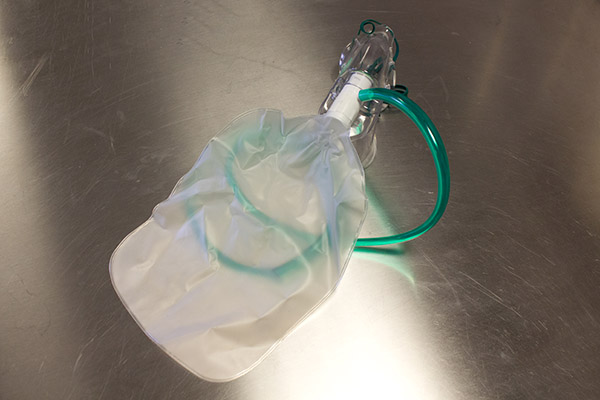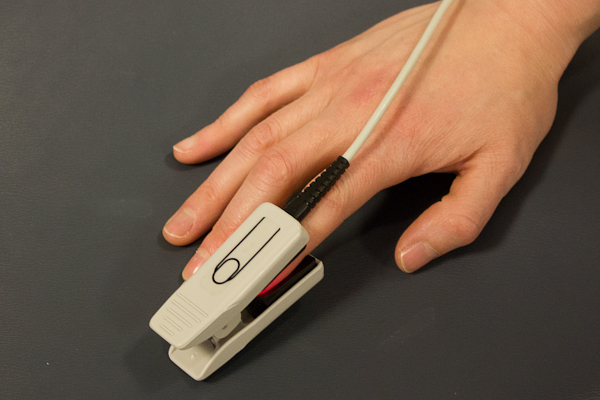
Reservoir mask
Specific management will depend on the cause of the respiratory failure (see further management section). Immediately life threatening respiratory conditions such as a severe asthma, tension pneumothorax or haemothorax should be treated without delay.

Initial management of an acutely unwell patient involves giving the patient O2 at 15L/min via a reservoir mask.
Following review by an expert it may be decided that supplemental oxygen via a reservoir mask is not required. This is highlighted in the BTS guideline “Oxygen Therapy Use in Adults in Healthcare and Emergency Settings” and in the Oxygen therapy section on the next page”
Sit the patient up and attach monitoring (Pulse oximeter (O2 saturations monitor), Electrocardiogram (ECG), Blood pressure (BP) cuff).
The look, listen, feel approach can be used to assess breathing.
Video: Look, Listen, Feel breathing assessment.
The following table illustrates the examination findings of common respiratory problems.
| Chest Expansion | Trachea | Percussion | Breath Sounds/added sounds | Vocal Resonance | |
| Normal | Equal | Central | Resonant | Vesicular | Normal |
| Pneumothorax | Reduced on affected side | Shifted to affected side in simple, away from in tension pneumothorax | Hyper-resonant on affected side | Reduced breath sounds on affected side | Reduced on affected side |
| Pneumonia | Can be reduced on affected side | Central or shifted towards side of lobar collapse | Dull over affected zone | Reduced breath sounds, coarse crepitations, bronchial breathing over affected zone | Increased over affected zone |
| Pleural effusion | Reduced on affected side | Central or shifted away from affected side if large | Stony dull | Reduced/absent | Reduced over affected zone |
| Pulmonary Oedema | Equal | Central | Potentially dull bases (pleural effusions) | Fine inspiratory crepitations ranging from lung bases to throughout lungs | Reduced over affected zone |
| Asthma exacerbation | Equal but may be decreased if patient tired | Central | Normal | High pitched expiratory wheeze in severe attack | Normal |
| COPD exacerbation | Equal | Central | Resonant | Bilateral expiratory wheeze & crepitations | Normal |
| Pulmonary embolism | Equal | Central | Normal | Normal or localised crepitations / pleural rub | Normal |

A pulse oximeter measures oxygen saturations (sats or SpO2). It is an essential tool in monitoring acutely ill and deteriorating patients. Oxygen saturation is related to the Arterial partial pressure of oxygen (PaO2) by the oxygen dissociation curve. It is not a linear relationship but an oxygen saturation of 94% approximately equates to a PaO2 of 8 kPa. If the PaO2 drops below 8 kPa then a rapid fall in saturations occurs due to the shape of the oxygen dissociation curve. Normally oxygen saturations are > 94-98%, but patients with chronic respiratory disease may be used to significantly lower saturations (88-92%). A pulse oximeter does not detect hypercapnoea or acidosis therefore cannot be used to assess the adequacy of ventilation. An arterial blood gas (ABG) is required to measure the arterial partial pressure of carbon dioxide (PaCO2).